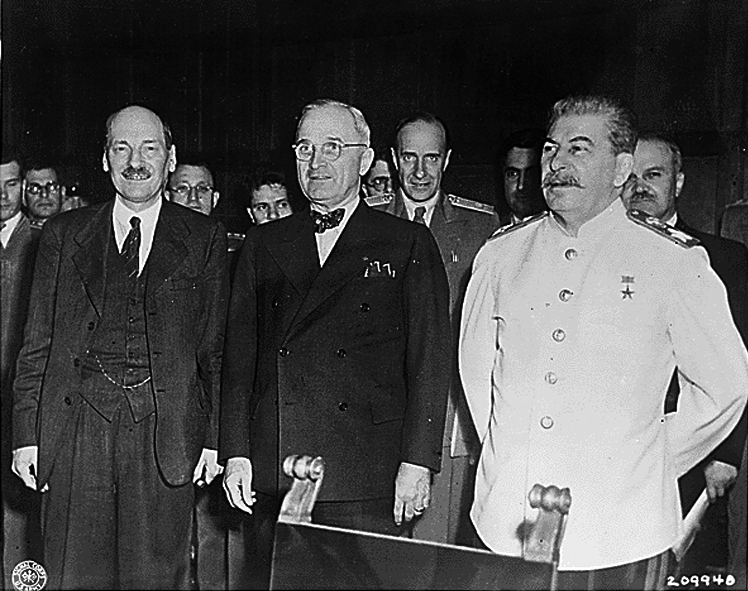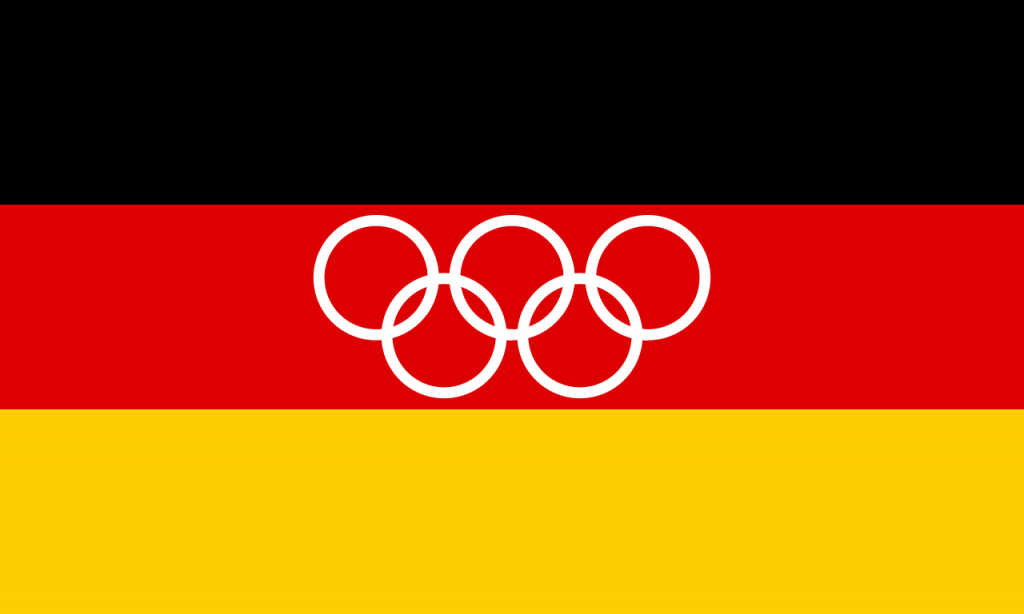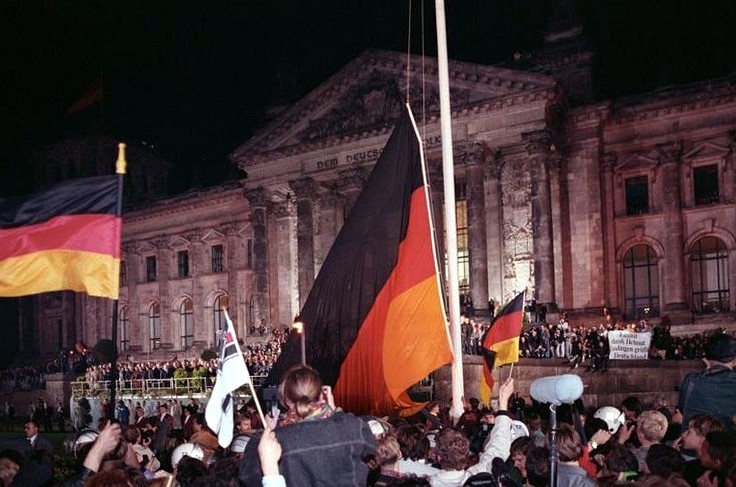The East German flag may seem an odd choice to cover here. After all, the country doesn’t exist anymore! But that’s missing the point. The east German state is fascinating! And its history is very much tied up in what we’re all about. The Young Pioneers we take our name from have so many roots in that! While it may be just a little further west than the states we usually look at, this westernmost tip of Soviet socialist influence has a lot of interesting things to learn about. And what better place than to start than with its flag? Let’s get to it.
East German flag in the Post War Years

In the aftermath of WW2, the joint-Allied forces in Germany had met up but could not push further… And were not inclined to move back, lest the other advance. While the Soviets and other allies may have been happy to team up to stomp some fascists for a bit, the question became… Who has the right to oversee Germany’s transition? An agreement was settled. One that initially saw a jointly administered Germany with ‘zones’ of control, aiming to have a unified Germany at the end of it. But nobody really seemed to trust each-other. So that transition went on and on… For that time, there pretty much was no German flag, let alone an East German flag.
The first things the allies wanted out of Germany was disarmament and reparations. In the eastern zone, reparations were acquired by the USSR primarily through direct seizure of Nazi owned private property to use for relief effort, as well as the mass ripping up of infrastructure like railway lines to bring to the east. This simultaneously weakened the region and beheaded the local bourgeoisie, many of which fled to the west.. The thing is… The western zones didn’t do this. In fact, much of the western zone’s debt was essentially forgiven, while America poured money into redeveloping the economy. While the west developed, the Soviets stripped a third of the east’s productive capacity within two years.
Economically and politically, the regions were growing apart while the state itself largely didn’t exist. This was awkward, because the idea had been for Germany to be reunited, but it was clear that conflicting interests would make it unacceptable to either side. It was actually the west that finally caved and decided to give up on the whole ‘reunification’ idea in March of 1948, planning the development of a west German republic in the French, British and American zones. Battle lines drawn, the Soviets announced their own intentions to form an east German state and now where does that leave us? The first run of German flags.
In actual fact, the west and east German flag were one and the same to begin with. The black, red and gold tricolour we see as the German flag to this day was first seen in the ‘German confederation‘ in 1848, an early union of Germanic states that pre-dated the oft-despised German empire. While it was also the flag of the Weimar republic, an also-maligned ex-German state, west Germany still chose the flag to depict the continuation of the German state. The eastern zone meanwhile initially flirted with other ideas, but ultimately declared their use of the same black, red and gold flag on the 7th of October, 1949 which marked the founding of the German Democratic Republic.
East German Flag Evolves


Not all hope had been given up on having a united Germany, so it suited for the flags to stay the same. This was just a temporary political arrangement and soon they would integrate again! …But time went by. The 50s rolled on and both states established themselves more concretely. A 1952 push by Stalin to have a unified but neutral Germany was struck down by the west who saw it as Germany’s right to join NATO against the Soviets. That further sealed its fate. On the 9th of May 1955, west Germany joined NATO. On the 14th, east Germany joined the Warsaw Pact. Relations were becoming untenable and eventually, on the 1st of October 1959, the east German flag changed.
The decision was made to integrate the flag with east Germany’s coat of arms. The emblem of course was already around, having been first assigned as the emblem on January 12th 1950. This symbol was quite different though, only featuring the middle hammer and two strands of wheat to encircle it, reflecting the state of peasants and workers. On the 28th of May, 1953, the hammer was redesigned and was joined with a compass, representing the intelligentsia in much the same way as the calligraphy brush for the symbol of Juche. The wheat was expanded into rows with the base wrapped in the simple tricolour. In 1955, it was amended once more to have a red inner-background.
So the new east German flag pretty much solidified itself there and really, it did the job perfectly. The tricolour had been a German symbol in multiple governments dating back over a hundred years, while also used by the other half of Germany. By using it, you’re directly competing for the legacy of the old German republics. The emblem meanwhile is a perfect demonstration of the country’s ethos in uniting the proletariat, peasantry and intelligentsia, with the emblem placed right in the red part of the flag if you don’t quite get it yet. It screamed “We’re the communist Germany” without aping off the hammer and sickle the Soviets had already created.
West Germany did not respond positively. In fact, they saw the new east German flag as a major break from reunification efforts, branding it a secessionist flag and outlawing its use in the west. Police would forcibly remove such flags until a decision was finally made on the 22nd July 1969 that it was unconstitutional to outlaw it. That’s still a good ten years of it being banned, but it seemed priorities had shifted by then to tacit acceptance of the two different nations. Now I wonder what may have prompted that?
The Unified German Olympic Flag

Despite all the hard work to break the relations between the two Germany’s apart, there was no getting past the fact that it was the same country and people across the political divide wanted reunification. In a lot of cases, the desire for unification transcended the capitalist/socialist dichotomy, so there were pushes to normalize relations and sort something out. One big symbolic step came with the Olympic games. It had already been decided in 1956 that the two Germany’s would send out a unified team, which was easy when they shared the same flag, but something had to change for 1960. Thankfully, a compromise was reached.
The United Team of Germany competed at the games with the tricolour flag featuring an Olympic logo instead of the east German flag’s own logo. This clearly delineated it from both countries while still holding the essence of both. To prevent arguments over the anthem played, the Beethoven symphony Ode to Joy was used as the German unified anthem, expressing a uniquely German spirit that can be applied to any ideology. The union was a success, followed with another unified Olympic team in 1964. This aligned closely with the so-called ‘Khrushchev thaw’ of the 60s, where east-west relations grew uncharacteristically close. A remarkably similar thing happened with Korea recently.
It, alas, was not to last. 1968 saw the Warsaw pact invasion of Czechoslovakia and a rapid reversal of relations. For that year, the two Germany’s refused to participate on the same team but did at least maintain the Olympic flag and Ode to Joy. Relations soured further during the 68 Winter Olympics as an East German athlete was aided in defecting to the west, sealing the split between them and setting the scene for fully independent, national-flag using Olympic teams in 1972. Perhaps the choice to unban the east German flag in 1969 was simply out of recognition that unification efforts were failing and the east was a distinct political entity. Or perhaps not.
The End of the East German Flag

As we all know, the socialist bloc didn’t exactly last forever. In Europe it collapsed entirely, with the Berlin wall falling in 1989 to spell the end of East Germany… Except that’s not really true. Sure, the Berlin wall fell in 1989, but the wall is not the government. The GDR continued going right up to October of 1990, in which time things were… Complete goddamn chaos. The ruling socialist party relinquished its authority and began the ‘East German Round Table’ talks among a large grouping of different new parties intended to reform the GDR’s constitution but maintain its independence. That was a pretty tough position to take at the time.
Throughout December of 1989, the round table negotiated reforms in preparation for free and fair elections in May of 1990 (which got pushed to March, giving them even less time). The assumption at the time, based on the feelings of parties present, was that the GDR should still maintain independence for the time being and figure out what it wanted to be as a state. What wasn’t expected was the massive involvement of west-German parties and west-German capital to support their election campaign, destroying initial expectations of a pro-GDR coalition victory and just barely snatching a pro-western government.
The draft constitution was unveiled in April of 1990, after the election failure and so its measures were largely ignored. Notable among the many alterations is Article 43, which proposed “The state flag of the German Democratic Republic bears the colors black, red and gold. The coat of arms of the state is the representation of the motto “swords to plowshares”.” Now does this mean that this new coat of arms would replace the GDR emblem in the flag, or would it merely be the coat of arms while the flag returned to black, red and gold? It’s hard to say, but what we have here is a glimpse of what might have been, had the election gone differently.
With that, we reach our conclusion. The GDR is no more and the East German flag is no more. Of course, the east German flag isn’t completely gone. You’ll find it on plenty of ‘ostalgie’ kitsch and even flown in Germany on international workers day by those who believe the socialist state should have lived on. On the whole, it has passed into history. And what a fascinating history it is.





